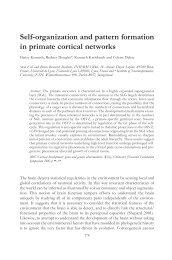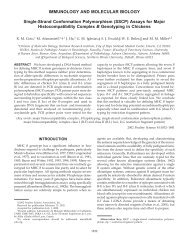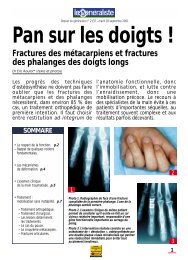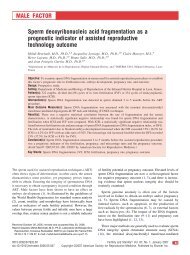Inducible site-specific recombination in myelinating ... - SECO Project
Inducible site-specific recombination in myelinating ... - SECO Project
Inducible site-specific recombination in myelinating ... - SECO Project
Create successful ePaper yourself
Turn your PDF publications into a flip-book with our unique Google optimized e-Paper software.
© 2002 Wiley-Liss, Inc. genesis 35:63–72 (2003)TECHNOLOGY REPORT<strong>Inducible</strong> Site-Specific Recomb<strong>in</strong>ation <strong>in</strong> Myel<strong>in</strong>at<strong>in</strong>g CellsNathalie H. Doerfl<strong>in</strong>ger, 1 Wendy B. Mackl<strong>in</strong>, 2 and Brian Popko 3 *1 Institut de Génétique et de Biologie Moleculaire et Cellulaire (IGBMC), CNRS, Université Louis Pasteur, Illkirch, France2 Department of Neurosciences, Lerner Research Institute, Cleveland Cl<strong>in</strong>ic Foundation, Cleveland, Ohio3 Center for Peripheral Neuropathy, Department of Neurology, University of Chicago, Chicago, Ill<strong>in</strong>oisReceived 21 June 2002; Accepted 6 August 2002Summary: To explore the function of genes expressedby myel<strong>in</strong>at<strong>in</strong>g cells we have developed a model systemthat allows for the <strong>in</strong>ducible ablation of predeterm<strong>in</strong>edgenes <strong>in</strong> oligodendrocytes and Schwann cells. The Cre/loxP <strong>recomb<strong>in</strong>ation</strong> system provides the opportunity togenerate tissue-<strong>specific</strong> somatic mutations <strong>in</strong> mice. Wehave used a fusion prote<strong>in</strong> between the Cre recomb<strong>in</strong>aseand a mutated ligand-b<strong>in</strong>d<strong>in</strong>g doma<strong>in</strong> of the humanestrogen receptor (CreER T ) to obta<strong>in</strong> <strong>in</strong>ducible, <strong>site</strong>-<strong>specific</strong><strong>recomb<strong>in</strong>ation</strong>. CreER T expression was placed underthe transcriptional control of the regulatory sequencesof the myel<strong>in</strong> proteolipid prote<strong>in</strong> (PLP) gene,which is abundantly expressed <strong>in</strong> oligodendrocytes andto a lesser extent <strong>in</strong> Schwann cells. The CreER T fusionprote<strong>in</strong> translocated to the nucleus and mediated the<strong>recomb<strong>in</strong>ation</strong> of a LacZ reporter transgene <strong>in</strong> myel<strong>in</strong>at<strong>in</strong>gcells of PLP/CreER T mice <strong>in</strong>jected with the syntheticsteroid tamoxifen. In untreated animals CreER T rema<strong>in</strong>edcytoplasmic, and there was no evidence of <strong>recomb<strong>in</strong>ation</strong>.The PLP/ CreER T animals should be veryuseful <strong>in</strong> elucidat<strong>in</strong>g and dist<strong>in</strong>guish<strong>in</strong>g a particulargene’s function <strong>in</strong> the formation and ma<strong>in</strong>tenance of themyel<strong>in</strong> sheath and <strong>in</strong> analyz<strong>in</strong>g mature oligodendrocytefunction <strong>in</strong> pathological conditions. genesis 35:63–72,2003. © 2002 Wiley-Liss, Inc.Key words: myel<strong>in</strong>at<strong>in</strong>g cells; CreER T ; <strong>recomb<strong>in</strong>ation</strong>INTRODUCTIONThe myel<strong>in</strong> sheath is the multilayered membrane structurethat surrounds most nerve axons and facilitatesrapid nerve conduction velocities by promot<strong>in</strong>g salutatoryconduction. Oligodendrocytes are responsible formyel<strong>in</strong>at<strong>in</strong>g the central nervous system (CNS), andSchwann cells myel<strong>in</strong>ate the peripheral nervous system(PNS). Myel<strong>in</strong>at<strong>in</strong>g cells express a number of moleculescritical to their differentiated function (Morell andQuarles, 1999; Baumann et al., 2001; Garbay et al.,2000). A better understand<strong>in</strong>g of the molecular mechanismsby which these cells form and ma<strong>in</strong>ta<strong>in</strong> the myel<strong>in</strong>sheath will likely advance our understand<strong>in</strong>g of thiscritical structure, as well as facilitate the development ofstrategies for the repair of the <strong>in</strong>jured sheath <strong>in</strong> demyel<strong>in</strong>at<strong>in</strong>gdiseases such as multiple sclerosis and chronic<strong>in</strong>flammatory polyneuropathy (Scherer, 1997; Duncan etal., 1997).The exam<strong>in</strong>ation of mouse mutants, spontaneous andexperimentally eng<strong>in</strong>eered, that are <strong>specific</strong>ally deficient<strong>in</strong> a particular myel<strong>in</strong> component has been an <strong>in</strong>valuabletool <strong>in</strong> the analysis of the myel<strong>in</strong>ation process (Werner etal., 1998; Suter et al., 1999; Mart<strong>in</strong>i, 2000; Yool et al.,2000). To date, these mutations have been present <strong>in</strong> allcells at all stages of development <strong>in</strong> the animals exam<strong>in</strong>ed.Such models are satisfactory for molecules that are“myel<strong>in</strong> <strong>specific</strong>,” but to determ<strong>in</strong>e the function of moleculesmore widely expressed, the analysis of myel<strong>in</strong>at<strong>in</strong>gcell-<strong>specific</strong> mutants is preferable.Fortunately, new tools have been developed that allowfor the generation of conditional genome alterationsby controll<strong>in</strong>g the tissue or cellular <strong>specific</strong>ity of the<strong>in</strong>troduced mutations (Gao et al., 1999). Conditionalsomatic mutations can be obta<strong>in</strong>ed us<strong>in</strong>g a <strong>recomb<strong>in</strong>ation</strong>system based on the bacteriophage P1 <strong>site</strong>-<strong>specific</strong>Cre recomb<strong>in</strong>ase (Kuhn et al., 1995; Nagy, 2000) underthe control of either a tissue- or cell-<strong>specific</strong> promoter.The Cre recomb<strong>in</strong>ase efficiently catalyzes molecular <strong>recomb<strong>in</strong>ation</strong>at <strong>specific</strong> 34-bp sequences termed loxP<strong>site</strong>s. Any DNA segment flanked by loxP <strong>site</strong>s, <strong>in</strong> thesame orientation, will be deleted <strong>in</strong> cells express<strong>in</strong>g theCre recomb<strong>in</strong>ase but will rema<strong>in</strong> <strong>in</strong>tact <strong>in</strong> nonexpress<strong>in</strong>gcells. Numerous studies have demonstrated that Cremediated<strong>recomb<strong>in</strong>ation</strong> can occur <strong>in</strong> a variety of celltypes (Sauer et al., 1989; Kuhn et al., 1995; Kellendonket al., 1999; Feltri et al., 1999; Nagy et al., 2000). Furthermore,several recent studies have described miceexpress<strong>in</strong>g Cre recomb<strong>in</strong>ase under the control of the* Correspondence to: Brian Popko, Jack Miller Center for PeripheralNeuropathy, Department of Neurology, University of Chicago, 5841 SouthMaryland Ave, MC2030, Chicago, IL 60637-1470.E-mail: bpopko@neurology.bsd.uchicago.eduGrant sponsors: Institut National de la Santé et de la Recherché Médicale(INSERM), Va<strong>in</strong>cre les Maladies Lysosomales (VML), and the Multiple SclerosisSociety.Grant sponsor: National Institutes of Health, Grant numbers: NS027336and NS034939.DOI: 10.1002/gene.10154
64 DOERFLINGER ET AL.myel<strong>in</strong> basic prote<strong>in</strong> (MBP) promoter that allow for the<strong>in</strong>troduction of oligodendroglial-<strong>specific</strong> alterations(Niwa-Kawakita et al., 2000; Hisahara et al., 2000; Sato etal., 2001).In addition to spatial <strong>specific</strong>ity, the control of temporal<strong>specific</strong>ity is also a desirable feature of an <strong>in</strong> vivo<strong>recomb<strong>in</strong>ation</strong> system. For example, <strong>specific</strong> moleculesmay play dist<strong>in</strong>ct functions <strong>in</strong> the formation versus thema<strong>in</strong>tenance of the myel<strong>in</strong> sheath. Steroid hormone receptorshave been exploited to confer temporal controlto the Cre recomb<strong>in</strong>ase (Metzger et al., 1995; Kellendonket al., 1996). For example, Feil et al. (1996) developeda system for regulat<strong>in</strong>g the temporal <strong>specific</strong>ity of<strong>recomb<strong>in</strong>ation</strong> by generat<strong>in</strong>g a Cre recomb<strong>in</strong>ase fused toa mutated ligand b<strong>in</strong>d<strong>in</strong>g doma<strong>in</strong> of the human estrogenreceptor (ER). The mutant ER (ER T ) is activated by thesynthetic steroid tamoxifen but not by endogenous estradiol(Feil et al., 1996). The CreER T fusion prote<strong>in</strong>translocates from the cytoplasm of the cell, where it isfunctionally <strong>in</strong>active, to the nucleus when bound totamoxifen, thus allow<strong>in</strong>g temporally (tamoxifen) controlledsomatic mutagenesis of floxed target genes.We set out to generate a mouse model system thatwould allow for the spatial and temporal control of gene<strong>in</strong>activation <strong>in</strong> myel<strong>in</strong>at<strong>in</strong>g cells. Toward this goal, transgenicmice were generated <strong>in</strong> which CreER T expressionwas driven to myel<strong>in</strong>at<strong>in</strong>g cells us<strong>in</strong>g the regulatorysequences of the mur<strong>in</strong>e proteolipid prote<strong>in</strong> (PLP) gene(Wight et al., 1993; Griffiths et al., 1998). The expressionof transgenes driven by this PLP transcriptionalcontrol region is cell-type <strong>specific</strong>, primarily restricted tomyel<strong>in</strong>at<strong>in</strong>g oligodendrocytes <strong>in</strong> the CNS (Wight et al.,1993; Fuss et al., 2000, 2001) and Schwann cells <strong>in</strong> thePNS (Mallon et al., 2002). Furthermore, PLP is expressedearlier than MBP dur<strong>in</strong>g development, beg<strong>in</strong>n<strong>in</strong>g dur<strong>in</strong>gembryonic life and at early developmental stages of theoligodendroglia l<strong>in</strong>eage (Wight et al., 1993; Belachew etal., 2001; Mallon et al., 2002). PLP-promoter-driven CreER Ttransgenic mice should allow for the molecular assessmentof myel<strong>in</strong>at<strong>in</strong>g cell development and function <strong>in</strong>vivo from the progenitor stage to mature myel<strong>in</strong>at<strong>in</strong>gcells (Spassky et al., 1998; Belachew et al., 2001).Previous studies have shown that the first half of themouse PLP gene, conta<strong>in</strong><strong>in</strong>g 2.4 kb of 5 flank<strong>in</strong>g DNA,exon 1 and <strong>in</strong>tron 1, is sufficient to direct both spatialand temporal transgene transcription that accurately reflectsthe expression of the endogenous PLP gene(Wight et al., 1993; Fuss et al., 2000, 2001). Three<strong>in</strong>dependent l<strong>in</strong>es were generated carry<strong>in</strong>g the PLP/Cre-ER T transgene (Fig. 1A). Mice of all PLP/CreER T l<strong>in</strong>eswere fertile, transmitted the transgene <strong>in</strong> a Mendelianfashion, and showed no signs of disease. RT-PCR data,generated us<strong>in</strong>g a primer set that amplifies a region thatspans the <strong>in</strong>tron <strong>in</strong> the transgene, demonstrates thepresence of transgene-derived mRNA primarily <strong>in</strong> CNS(bra<strong>in</strong> and sp<strong>in</strong>al cord), but also weakly <strong>in</strong> heart andtestis <strong>in</strong> animals of each l<strong>in</strong>e (Fig. 1B). PLP/DM20 mRNAexpression has previously been shown to be present <strong>in</strong>heart at levels at about 0.1% of that present <strong>in</strong> the bra<strong>in</strong>(Campagnoni et al., 1992), and PLP-driven mRNA wasdetected <strong>in</strong> the testis of transgenic animals (Fuss et al.,2000).To exam<strong>in</strong>e the expression of the CreER T prote<strong>in</strong> <strong>in</strong>the three transgenic l<strong>in</strong>es, we performed Western blotanalyses us<strong>in</strong>g polyclonal antibody aga<strong>in</strong>st the Cre prote<strong>in</strong>(Kellendonk et al., 1999) (Fig. 1C). In bra<strong>in</strong> samplesfrom transgenic mice of the three different l<strong>in</strong>es, a prote<strong>in</strong>with an apparent molecular weight of 67 kDa wasdetected. This corresponds to the expected size of recomb<strong>in</strong>antCreER T fusion prote<strong>in</strong>. No expression of CreER Tprote<strong>in</strong> was detectable <strong>in</strong> wild-type animal (Fig. 1C).We further characterized the expression of the CreER Tprote<strong>in</strong> by immunohistochemistry <strong>in</strong> adult sections ofbra<strong>in</strong>, optic, and sciatic nerves us<strong>in</strong>g the same antiserumas used for immunoblott<strong>in</strong>g. Expression of the CreER Tprote<strong>in</strong> is localized predom<strong>in</strong>antly <strong>in</strong> white matter areas,with a scattered distribution with<strong>in</strong> corpus callosum,anterior commissure, cerebellum, sp<strong>in</strong>al cord, optic, andsciatic nerves (Fig. 2), and is consistent with the endogenousexpression of the PLP gene (Wight et al., 1993).The expression profile is essentially the same for allthree PLP/CreER T transgenic l<strong>in</strong>es. At the same time, noexpression of CreER T prote<strong>in</strong> is detectable <strong>in</strong> wild-typeanimals (data not shown).To assess the identity of the CreER T -positive cells <strong>in</strong>the CNS we performed several double-label<strong>in</strong>g immunohistochemistryexperiments on frozen bra<strong>in</strong> sagittal sectionsand exam<strong>in</strong>ed areas with relatively simple morphology,such as cerebellum (Fig. 3A–C). Analysis ofCreER T label<strong>in</strong>g us<strong>in</strong>g confocal imag<strong>in</strong>g techniques revealedCreER T -positive cell bodies <strong>in</strong> all white mattertracts (red label<strong>in</strong>g, Fig. 3A, D). For a more accuratelocalization of oligodendrocytes and their myel<strong>in</strong> sheath,monoclonal antibodies <strong>specific</strong> for MBP and PLP wereused. As expected, cells positive for CreER T could beidentified <strong>in</strong> areas that were positive for MBP or PLP(green label<strong>in</strong>g, Fig. 3B and 3C, respectively). CreER T -derived fluorescence was conf<strong>in</strong>ed to cell bodies. Nevertheless,a precise colocalization of cell bodies doublepositive for CreER T and MBP or PLP <strong>in</strong> myel<strong>in</strong>-rich CNSareas was not easily obta<strong>in</strong>ed s<strong>in</strong>ce MBP and PLP aremyel<strong>in</strong>-associated and do not accumulate <strong>in</strong> the cellbodies. Occasionally s<strong>in</strong>gle cells could be dist<strong>in</strong>guishedat the edges of the white matter tracts where the overallMBP or PLP sta<strong>in</strong> was less, with clear CreER T -positive cellbodies and MBP- or PLP-positive cytoplasm and processes(Fig. 3A–C). To assess the identity of CreER T -positive cells more accurately, we used antibodies that<strong>specific</strong>ally label oligodendrocyte cell bodies (clone CC1of adenomatous polyposis coli prote<strong>in</strong> and gluthathiones-transferasePi [GST-Pi]), processes and somata of astrocytes(anti-glial fibrillary acidic prote<strong>in</strong> [GFAP]), and neuronalcell bodies and dendrites (clone SMI32 ofneurofilament H) for double-label<strong>in</strong>g experiments (Fig.3D–I). As representative CNS regions, we analyzed corpuscallosum, sp<strong>in</strong>al cord and cerebellum. These studiesclearly demonstrated that neither astrocytes nor neuronswere labeled by CreER T (Fig. 3H, I). In general, a major-
INDUCIBLE CRE IN MYELINATING CELLS65FIG. 1. Transgene construct and PLP/CreER T expression <strong>in</strong> transgenic mice. (A) Structure of the PLP/CreER T transgene and strategy to thedetection of CreER T mRNA by RT-PCR. To generate transgenic PLP/CreER T mice we used the PLP cassette conta<strong>in</strong><strong>in</strong>g 2.4 kb of the5-flank<strong>in</strong>g DNA, exon 1 and <strong>in</strong>tron 1 of the PLP gene (black-and-white diagonally striped boxes), which have been shown to drive abundantoligodendrocyte expression (Fuss et al., 2000). For transcription term<strong>in</strong>ation, a simian virus (SV) 40 poly(A) signal sequence (horizontallystriped box) is present 3 of the cDNA sequence encod<strong>in</strong>g CreER T (CreER T box). White boxes represent vector sequences. (B) RT-PCRanalysis of CreER T mRNA expression. RNA was isolated from bra<strong>in</strong> (B), sp<strong>in</strong>al cord (SC), liver (L), spleen (Sp), kidney (K), heart (H), lung (Lu),and testis (T) of 3-week-old PLP/CreER T mice. RT-PCR products correspond<strong>in</strong>g to PLP/CreER T mRNA (fusion between PLP exon 1 andCreER T cod<strong>in</strong>g sequence) and GAPDH mRNA used as an <strong>in</strong>ternal control are <strong>in</strong>dicated. (C) Western blot analysis of CreER T expression.Twenty g of total prote<strong>in</strong> of bra<strong>in</strong> from 3-week-old PLP/CreER T and littermate control mice were analyzed. Membrane was <strong>in</strong>cubated withpolyclonal anti-Cre recomb<strong>in</strong>ase and monoclonal anti-act<strong>in</strong> antibodies. All three express<strong>in</strong>g transgenic l<strong>in</strong>es and wild-type (wt) sample areshowed. The expected <strong>specific</strong> band sizes are 67 kDa and 42 kDa for recomb<strong>in</strong>ant CreER T fusion prote<strong>in</strong> and act<strong>in</strong>, respectively.ity of the CreER T -positive cells were also CC1 (Fig. 3D, E)or GST-Pi (Fig. 3F, G) positive. The above data confirmeda restricted expression pattern of CreER T <strong>in</strong> myel<strong>in</strong>at<strong>in</strong>goligodendrocytes <strong>in</strong> the CNS of PLP/CreER T mice.To exam<strong>in</strong>e the steroid response of CreER T -express<strong>in</strong>goligodendrocytes, we compared the <strong>in</strong>tracellular localizationof the chimeric prote<strong>in</strong> upon treatment of transgenicmice with tamoxifen or oil carrier alone. Immunohistochemistryanalyses were performed on frozensp<strong>in</strong>al cord sections us<strong>in</strong>g polyclonal anti-Cre antibodyand DAPI to sta<strong>in</strong> cell nuclei. In the absence of tamoxifentreatment, all CreER T prote<strong>in</strong> was excluded from thenucleus (Fig. 4A, B). Three days of 1 mg/day tamoxifentreatment was sufficient to <strong>in</strong>duce nuclear translocationof CreER T (Fig. 4C, D).The <strong>specific</strong>ity of Cre-mediated <strong>recomb<strong>in</strong>ation</strong> wastested functionally by cross<strong>in</strong>g the PLP/CreER T -express<strong>in</strong>gmice to animals harbor<strong>in</strong>g a floxed -galactosidase(LacZ) reporter transgene (Araki et al., 1995). In thereporter mice, LacZ expression is only activated <strong>in</strong> cellsthat express functional Cre recomb<strong>in</strong>ase, which removesa stop signal from the floxed transgene. Doubletransgenicanimals were treated for 8 consecutive dayswith a s<strong>in</strong>gle daily <strong>in</strong>jection of oil carrier or 1 mg/day oftamoxifen. The <strong>recomb<strong>in</strong>ation</strong> event was analyzed byPCR <strong>in</strong> various tissues of the PLP/CreER T :floxed LacZreporter mice. Recomb<strong>in</strong>ation of the floxed LacZ transgenewas scored by amplification of a 384-bp PCR productus<strong>in</strong>g primers described by Niwa-Kawakita (2000),AG10 and Z6 (Fig. 5). These primers also allowed amplificationof a 1972-bp product, correspond<strong>in</strong>g to thenonrecomb<strong>in</strong>ed transgene, which was observed <strong>in</strong> allsamples (Fig. 5). In tamoxifen-treated floxed LacZ reportermice carry<strong>in</strong>g the PLP/CreER T transgene, the
66 DOERFLINGER ET AL.FIG. 2. PLP/CreER T prote<strong>in</strong> expressionpattern <strong>in</strong> central nervoussystem and peripheralnervous system. Immunohistochemicalsta<strong>in</strong><strong>in</strong>g of CreER T recomb<strong>in</strong>ase(brown cell bodies)was performed on sections of5-week-old PLP/CreER T l<strong>in</strong>e 3mice bra<strong>in</strong> (A–D), optic (E), andsciatic (F) nerves us<strong>in</strong>g the samepolyclonal anti-Cre antibodies asfor Western blots. Expression ofthe transgene is localized predom<strong>in</strong>antly<strong>in</strong> white matter areasand was consistent with the endogenousexpression of the PLPgene. Details of this sta<strong>in</strong><strong>in</strong>g isshowed <strong>in</strong> corpus callosum (A),anterior commissure (B), cerebellum(C), sp<strong>in</strong>al cord (D), optic (E),and sciatic (F) nerves. Scalebars 50 m.384-bp fragment <strong>specific</strong> for the deleted transgene wasamplified pr<strong>in</strong>cipally <strong>in</strong> the CNS samples analyzed, thusconfirm<strong>in</strong>g the spatial and temporal <strong>specific</strong>ity of thePLP transgene for the CNS. Nevertheless, consistent withthe PLP/CreER T expression pattern described above, <strong>recomb<strong>in</strong>ation</strong>was also weakly observed <strong>in</strong> heart andtestis. At the same time, no deleted transgene was amplified<strong>in</strong> oil carrier treated animals (Fig. 5).To determ<strong>in</strong>e the cellular localization of Cre-mediated<strong>recomb<strong>in</strong>ation</strong> <strong>in</strong> the CNS and PNS, various tissue samplesfrom PLP/CreER T :floxed LacZ reporter mice, treatedby oil carrier or tamoxifen, were analyzed for expressionof -galactosidase by X-gal sta<strong>in</strong><strong>in</strong>g (Fig. 6). In reportermice carry<strong>in</strong>g the PLP/CreER T transgene, <strong>specific</strong> sta<strong>in</strong><strong>in</strong>gwas observed <strong>in</strong> various regions of the CNS, onlyafter tamoxifen treatment (Fig. 6A, B). Blue-sta<strong>in</strong>ed cellswere found primarily <strong>in</strong> white matter tracts of bra<strong>in</strong> (Fig.6C–F) and optic nerve (Fig. 6G). To a far lesser extentX-gal conversion was also detected <strong>in</strong> the sciatic nerves(Fig. 6H), confirm<strong>in</strong>g that the PLP promoter cassetteused <strong>in</strong>cludes elements that stimulate transcription <strong>in</strong>Schwann cells (Puckett et al., 1987; Mellon et al., 2002).Immunofluorescence sta<strong>in</strong><strong>in</strong>g for both LacZ and Crerecomb<strong>in</strong>ase prote<strong>in</strong> detected LacZ reporter expression<strong>in</strong> a significant proportion of Cre positive cells (Fig. 6A).F<strong>in</strong>ally, dual label immunocytochemistry for both LacZand CC1 primarily, although not exclusively, detected<strong>recomb<strong>in</strong>ation</strong> <strong>in</strong> oligodendroglial cells, as assessed byLacZ reporter expression, after Cre-mediated <strong>recomb<strong>in</strong>ation</strong>(Fig. 7B and C). It is unclear whether the lack ofuniform label<strong>in</strong>g of LacZ-positive cells by the oligodendroglialmarker reflects a population of oligodendrocytesthat do not express CC1, as the work of Fuss et al. (2000)would suggest, or whether the PLP/CreER T transgene isexpressed <strong>in</strong> nonoligodendroglial cells, or some comb<strong>in</strong>ationof these two possibilities.The comb<strong>in</strong>ation of the PLP promoter and the <strong>in</strong>ductionof the CreER T recomb<strong>in</strong>ase by tamoxifen yields ahighly selective conditional mutagenesis system for myel<strong>in</strong>at<strong>in</strong>gcells. The PLP/CreER T transgene is expressedprimarily <strong>in</strong> white matter tracts of the CNS, with lessexpression detected <strong>in</strong> Schwann cells, and even less <strong>in</strong>the heart and testis. In the CNS of these mice, cellslabeled by their CreER T expression could be clearlyidentified as mature oligodendrocytes by double immunocytochemicalstudies with oligodendrocyte-<strong>specific</strong>markers.Expression of the PLP gene was <strong>in</strong>itially thought tooccur exclusively <strong>in</strong> the CNS, but PLP is clearly alsoexpressed <strong>in</strong> Schwann cells (Puckett et al., 1987). The
INDUCIBLE CRE IN MYELINATING CELLS67FIG. 3. Oligodendroglial CreER T expression exam<strong>in</strong>ed by confocal imag<strong>in</strong>g. To assess the identity of the Cre-positive cells (red) <strong>in</strong> bra<strong>in</strong> weperformed double label<strong>in</strong>g (green) on 5-week-old frozen bra<strong>in</strong> sagittal sections with antibodies <strong>specific</strong> for myel<strong>in</strong> sheath: MBP (A, B) andPLP (C); oligodendrocyte cell bodies such a CC1 (D, E) and GST-Pi (F, G); neurons: neurofilament H (H); and astrocytes: GFAP (I). PanelsA and B show sections from l<strong>in</strong>e 3, panels C, D, E, F, G, and I display sections from l<strong>in</strong>e 46, and panel H is from l<strong>in</strong>e 16. Pictures show doublelabel<strong>in</strong>g, with s<strong>in</strong>gle (A/D) or double laser channel, localized <strong>in</strong> cerebellum (A/B/C), corpus callosum (D/E), or cerebellum (F/G/H/I). Scalebars 10 m, except for D and E, which equal 25 m.PLP expression cassette used <strong>in</strong> these studies conta<strong>in</strong>stranscriptional control elements that drive expressionalso <strong>in</strong> the PNS (Wight et al., 1993; Jiang et al., 2000;Mallon et al., 2002), where it is expressed <strong>in</strong> both myel<strong>in</strong>at<strong>in</strong>gand nonmyel<strong>in</strong>at<strong>in</strong>g Schwann cells (Jiang et al.,2000). The PLP promoter rema<strong>in</strong>s active after sciaticnerve transection (Jiang et al., 2000), which suggeststhat the <strong>in</strong>ducible system described here could be usedto <strong>in</strong>duce <strong>recomb<strong>in</strong>ation</strong> <strong>in</strong> experimental models of peripheralnerve <strong>in</strong>jury.The availability of the PLP/CreER T mice should allowfor the detailed characterization of the function of prote<strong>in</strong>sexpressed by oligodendrocytes. The targeted expressionof the Cre recomb<strong>in</strong>ase to these cells provides
68 DOERFLINGER ET AL.FIG. 4. Tamoxifen-<strong>in</strong>duced nucleartranslocation of CreER T recomb<strong>in</strong>ase.Four-week-old l<strong>in</strong>e3 PLP/CreER T :floxLacZ doubletransgenic mice were <strong>in</strong>jected for3 consecutive days with tamoxifen(1 mg/day) (C/D) or with thesunflower oil carrier alone (A/B).Immunohistochemistry aga<strong>in</strong>st Crewas performed on sp<strong>in</strong>al cordcryosections (A/B/CD). The redlabel corresponds to Cre sta<strong>in</strong><strong>in</strong>g(A/B/C/D) and the cyan label toDAPI sta<strong>in</strong><strong>in</strong>g (B/D) of the nuclei.FIG. 5. PCR detection of CreER T -mediated <strong>recomb<strong>in</strong>ation</strong> <strong>in</strong> mice.Four-week-old l<strong>in</strong>e 3 PLP/CreER T :floxLacZ transgenic mice were<strong>in</strong>jected with vehicle (oil) or tamoxifen (1 mg/day) for 8 consecutivedays. Excision of the floxed CAT cassette <strong>in</strong> various organs ofoil-treated mice (left panel) or tamoxifen-treated mice (right panel)was analyzed by PCR of the junction between the -act<strong>in</strong> promoterand the LacZ reporter gene. Recomb<strong>in</strong>ation was scored by amplificationof a 384-bp PCR product. The same primer set also allowedamplification of a 1972-bp PCR product correspond<strong>in</strong>g to the nonrecomb<strong>in</strong>edtransgene. Presented samples are water (W), as anegative control of the PCR; bra<strong>in</strong> (B), sp<strong>in</strong>al cord (Sc), liver (L),spleen (Sp), kidney (K), heart (H), lung (Lu), and testis (T).the means to tease out the oligodendroglial role playedby genes expressed <strong>in</strong> cell types <strong>in</strong> addition to oligodendroglia.The <strong>in</strong>ducible feature of the CreER T fusion prote<strong>in</strong>provides the opportunity to characterize the functionof oligodendroglial prote<strong>in</strong>s dur<strong>in</strong>g the myel<strong>in</strong>ationprocess, as well as <strong>in</strong> mature animals. Furthermore, asdemonstrated by the floxed LacZ reporter gene, thePLP/CreER T animals can be used to temporally activategene expression <strong>specific</strong>ally <strong>in</strong> oligodendrocytes. A majorproblem with transgenic studies us<strong>in</strong>g a developmentallyregulated promoter has been the expression oftransgenes throughout development as well as <strong>in</strong> maturecells. Thus, <strong>in</strong>vestigat<strong>in</strong>g the impact of a prote<strong>in</strong> <strong>in</strong> themature cell cannot be separated from its potential toalter the development of the cell. The ability to activatecre-mediated <strong>recomb<strong>in</strong>ation</strong> selectively <strong>in</strong> oligodendrocytesprovides the opportunity to <strong>in</strong>vestigate the functionof prote<strong>in</strong>s <strong>in</strong> mature oligodendrocytes that havedeveloped normally. These animals offer another tool <strong>in</strong>our efforts to comprehensively characterize the myel<strong>in</strong>ationprocess and at the same time <strong>in</strong>vestigate the functionof mature oligodendrocytes <strong>in</strong> normal and pathologicalenvironments.MATERIALS AND METHODSGeneration of the PLP/CreER T Transgenic L<strong>in</strong>eFor cell type-<strong>specific</strong> expression of the Cre recomb<strong>in</strong>ase,a 2-kb CreER T fragment, conta<strong>in</strong><strong>in</strong>g the Cre open read<strong>in</strong>gframe fused to a mutated form of the estrogen receptorligand b<strong>in</strong>d<strong>in</strong>g doma<strong>in</strong>, was first isolated from pCreER Tplasmid (Feil, 1996), which was k<strong>in</strong>dly provided by Dr.Pierre Chambon. This T4 DNA polymerase-treated EcoRIDNA fragment was <strong>in</strong>serted <strong>in</strong>to the SmaI <strong>site</strong> of a modifiedversion of the vector pNEB193 (Fuss et al., 2000).The pPLP/CreER T plasmid was constructed by clon<strong>in</strong>gthe 2.1-kb AscI-PacI restriction fragment conta<strong>in</strong><strong>in</strong>g theCreER T sequence <strong>in</strong>to the 14.5-kb PLP promoter cassetteconta<strong>in</strong><strong>in</strong>g 2.4 kb of the 5 flank<strong>in</strong>g DNA, exon 1, <strong>in</strong>tron1 of the mouse PLP gene and a SV40 poly(A) signalsequence (Fuss et al., 2000). The f<strong>in</strong>al 16.5-kb pPLP/CreER T construct was cut with ApaI and SacII to releasea 13-kb PLP/CreER T fragment conta<strong>in</strong><strong>in</strong>g the transgene.For detection of the transgene by PCR analysis the CreER Tprimers sense 5-GAT GTA GCC AGC AGC ATG TC-3
INDUCIBLE CRE IN MYELINATING CELLS69FIG. 6. X-Gal sta<strong>in</strong><strong>in</strong>g analysis ofCre-mediated <strong>recomb<strong>in</strong>ation</strong>. Todeterm<strong>in</strong>e the localization of Cre-ER T -mediated <strong>recomb<strong>in</strong>ation</strong> after<strong>in</strong>jection of tamoxifen (B–H) oroil carrier (A), various samples ofl<strong>in</strong>e 3 PLP/CreER T :floxLacZ mice[sagittal half-bra<strong>in</strong> (A/B) and30-m frozen sections of sagittalbra<strong>in</strong> (C–F), longitud<strong>in</strong>al optic (G)and sciatic (H) nerves] were analyzedfor expression of -galactosidaseby X-gal sta<strong>in</strong><strong>in</strong>g. In thecentral nervous system, only after<strong>in</strong>duction by tamoxifen, <strong>in</strong>tenseblue-sta<strong>in</strong>ed cells were found <strong>in</strong>many heavily myel<strong>in</strong>ated whitematter tracts (B) such as corpuscallosum (C), ventral sp<strong>in</strong>al cord(D), cerebellum (E), bra<strong>in</strong> stem (F),and optic nerve (G). Some scatteredblue-sta<strong>in</strong>ed cells were alsodetected <strong>in</strong> sciatic nerve (H).Scale bars 50 m (C–H).and reverse 5-ACT ATA TCC GTA ACC TGG AT-3 wereused to amplify a 532-bp PCR product.Detection of CreER T mRNA Synthesis <strong>in</strong>PLP/CreER T MiceCreER T mRNA was detected by reverse transcriptase(RT)-PCR. Total RNA was extracted from bra<strong>in</strong>, sp<strong>in</strong>alcord, liver, kidney, heart, lung, and testis tissues of3-week-old PLP/CreER T mice with the TRIzol Reagentmethod (Life Technologies). cDNA was synthesized for10 m<strong>in</strong> at 37°C us<strong>in</strong>g 200 units of Moloney mur<strong>in</strong>eleukemia virus RT and 2 g of RNA and was amplified by30 cycles of PCR at 55°C us<strong>in</strong>g primers sense (5-TCAGAG TCG CAA ACC TCG AG-3) and reverse (5-GATGTA GCC AGC AGC ATG TC-3) that amplify a 1.5-kbfragment of the PLP/CreER T cDNA. As an <strong>in</strong>ternal control,a 400-bp cDNA fragment of the glyceraldehyde-3-phosphate dehydrogenase (GAPDH) mRNA was amplified<strong>in</strong> the same condition us<strong>in</strong>g the sense and reverseprimers 5-CCA CTC ACG GCA AAT TCA ACG GCA-3and 5-TCC AGG CGG CAC GTC AGA TCC ACG-3,respectively.
70 DOERFLINGER ET AL.FIG. 7. Analyses of -galactosidase expression pattern by confocal imag<strong>in</strong>g. To assess the localization of -galactosidase-express<strong>in</strong>g cellsafter Cre-mediated <strong>recomb<strong>in</strong>ation</strong>, we performed double immunofluorescence label<strong>in</strong>g of - galactosidase (red) and Cre recomb<strong>in</strong>ase(green) (A) or-galactosidase (green) and CC1 (red) (B, C), on frozen tissue sections from 5-week-old l<strong>in</strong>e 3 PLP/CreER T :floxLacZ micetreated for 8 consecutive days with tamoxifen. Panel shows sta<strong>in</strong><strong>in</strong>g of sp<strong>in</strong>al cord (A), anterior commisure (B), and cerebellum (C). Yellowcells correspond to colocalization of both label<strong>in</strong>g. Scale bars 10 m.Western Blot Analysis of CreER T ExpressionTotal prote<strong>in</strong> extracts were prepared from bra<strong>in</strong> of3-week-old transgenic PLP/CreER T mice. Tissues werehomogenized <strong>in</strong> 1% sodium dodecyl-sulfate (SDS), PBS(pH 7.3) for 30 s us<strong>in</strong>g a manual potter, and boiled for 10m<strong>in</strong>. Insoluble material was removed by centrifugation at5000 g for 10 m<strong>in</strong>. Prote<strong>in</strong> concentrations were determ<strong>in</strong>edus<strong>in</strong>g a modified Lowryl assay (Bio-Rad, Inc.).Twenty micrograms of each prote<strong>in</strong> sample was resolvedon 10% Bis-Tris gel (Novex), transferred to PVDFmembranes (Millipore Corp.) and probed overnight at4°C with polyclonal anti-Cre antibody (Covance BabCo)or 1 h room temperature with monoclonal anti-act<strong>in</strong>(clone AC-40; Sigma) at dilution of 1:5000 and 1:500,respectively. Antibodies were detected by enhancedchemilum<strong>in</strong>escence detection system follow<strong>in</strong>g the <strong>in</strong>structionsof manufacturers (ECL Plus; Amersham).Immunohistochemical AnalysisFor immunohistochemistry, 5-week-old transgenic PLP/CreER T mice and nontransgenic littermate negative controlswere used. Anaesthetized mice were perfused <strong>in</strong>tracardiallywith PBS followed by 4% paraformaldehyde<strong>in</strong> 0.1 M phosphate buffer (PB), pH 7.3. Isolated tissueswere postfixed for 1h<strong>in</strong>thesame fixative, cryopreserved<strong>in</strong> 30% sucrose <strong>in</strong> PB for 48 h at 4°C, embedded<strong>in</strong> OCT and frozen before cryostat section<strong>in</strong>g (10–30m). Sections were permeabilized <strong>in</strong> 20°C acetone for10 m<strong>in</strong>, washed <strong>in</strong> PB, and blocked for 2hatroomtemperature (RT) <strong>in</strong> PB conta<strong>in</strong><strong>in</strong>g 10% (v/v) normalgoat serum and 0.1% (v/v) Triton X100 and <strong>in</strong>cubatedovernight at 4°C <strong>in</strong> athe primary polyclonal antibody(1:5000 dilution) generated aga<strong>in</strong>st the Cre prote<strong>in</strong> (Covance/BabCo)(Kellendonk et al., 1999), diluted <strong>in</strong> thesame block<strong>in</strong>g solution. After sections were r<strong>in</strong>sed <strong>in</strong> PBconta<strong>in</strong><strong>in</strong>g 0.1% (v/v) Triton X100, bound primary antibodieswere detected by <strong>in</strong>cubation with an anti-rabbitCy3-coupled for 2 h RT. Sections were mounted <strong>in</strong>Vectashield mount<strong>in</strong>g medium (Vector LaboratoriesInc.). For immunoperoxidase sta<strong>in</strong><strong>in</strong>g Cre immunoreactivitywas also detected, follow<strong>in</strong>g the primary antibody,by the avid<strong>in</strong>-biot<strong>in</strong> complex method (Vectasta<strong>in</strong> ABC-Elite kit; Vector Laboratories) and visualized with diam<strong>in</strong>obenzid<strong>in</strong>e(DAB) chromogen (Fig. 2). For double label<strong>in</strong>g,monoclonal primary antibodies used withpolyclonal Cre antibody were directed aga<strong>in</strong>st MBP(SMI99 clone; Sternberger Monoclonals Inc.), PLP (cloneplpc1; Serotec), Adenomatous polyposis coli prote<strong>in</strong>(APC) (clone CC1; Calbiochem-Novabiochem Corp.),gluthatione-S-transferase Pi form (GSTPi) (Biotr<strong>in</strong> IntLtd.), neurofilament H (SMI32 clone; Sternberger MonoclonalsInc.), and glial fibrillary acidic prote<strong>in</strong> (GFAP)(SMI22 clone; Sternberger Monoclonals Inc.) The aboveprocedure was repeated us<strong>in</strong>g anti-rabbit Cy3-coupledand anti-mouse conjugated to biot<strong>in</strong> secondary antibodiesfollowed by streptavid<strong>in</strong> fluoresce<strong>in</strong> (Jackson ImmunoResearch) to detect Cre polyclonal and mousemonoclonal antibodies, respectively. Images were generatedon a Leica TCS-NT laser scann<strong>in</strong>g microscope.Tamoxifen-Induced Nuclear Translocation ofCreER T Recomb<strong>in</strong>ationTo address the CreER T -mediated <strong>recomb<strong>in</strong>ation</strong>, thePLP/CreER T l<strong>in</strong>es were mated with a floxed LacZ (chicken-act<strong>in</strong> gene promoter-loxP-CAT gene-loxP-LacZ region)reporter l<strong>in</strong>e (Araki 1995), which was k<strong>in</strong>dly providedby Dr. Anton Berns, to generate doubleheterozygous transgenic mice PLP/CreER T :floxLacZ(Araki et al., 1995). A 10-mg/ml tamoxifen (ICN) stocksuspension was prepared for the <strong>in</strong>duction experimentby mix<strong>in</strong>g 10 mg tamoxifen with 100 l of ethanol and900 l of sunflower oil, followed by 30 m<strong>in</strong> sonication.Four-week-old PLP/CreER T :floxLacZ double-transgenicmice were <strong>in</strong>jected for 3 to 8 consecutive days <strong>in</strong>traperi-
INDUCIBLE CRE IN MYELINATING CELLS71toneally with 100 l of suspension (1 mg tamoxifen) orwith the sunflower oil carrier alone. Immunofluorescencelabel<strong>in</strong>g aga<strong>in</strong>st Cre was performed on sp<strong>in</strong>al cordcryosections as previously described and nuclei werevisualized with DAPI sta<strong>in</strong><strong>in</strong>g by add<strong>in</strong>g 0.01% DAPI(4,6-diamid<strong>in</strong>o-2-phenyl<strong>in</strong>dole dihydrochloride; Sigma)<strong>in</strong> Vectashield mount<strong>in</strong>g medium.Recomb<strong>in</strong>ation AnalysisPCR was also used to analyze CreER T -mediated excisionof the floxed CAT cassette from the floxLacZ target allele<strong>in</strong> various tissues of PLP/CreER T :floxLacZ double heterozygotesafter 8 days of treatment with tamoxifen oroil carrier. To explore the junction between the -act<strong>in</strong>promoter and LacZ, the primers AG10 and Z6 described<strong>in</strong> Niwa-Kawakita (2000) were used. Recomb<strong>in</strong>ation wasscored by amplification of a 384-bp PCR product. Thesame primer set also allowed amplification of a 1972-bpfragment correspond<strong>in</strong>g to the nonrecomb<strong>in</strong>ed transgene.Beta-Galatosidase HistochemistryRecomb<strong>in</strong>ation of the floxed LacZ transgene was analyzedby identification of -galactosidase-express<strong>in</strong>g cellsafter sta<strong>in</strong><strong>in</strong>g with 5-bromo-4-chloro-3-<strong>in</strong>dolyl--galactopyranoside(X-gal) as described by Wight et al. (1993).Briefly, anaesthetized mice were perfused <strong>in</strong>tracardiallywith PBS followed by 1% paraformaldehyde, 0.5% glutaraldehyde<strong>in</strong> PBS, pH 7.3, and f<strong>in</strong>ally <strong>in</strong> the same fixativeconta<strong>in</strong><strong>in</strong>g 10% sucrose. Tissues were immersed <strong>in</strong> thefixative solution conta<strong>in</strong><strong>in</strong>g 10% sucrose. Half-bra<strong>in</strong>(hand-cut sagittally along the <strong>in</strong>terhemispheric fissure),sciatic, and optic nerves were directly whole sta<strong>in</strong>ed.Upon dropp<strong>in</strong>g, other half-bra<strong>in</strong> sank <strong>in</strong> the same solutionconta<strong>in</strong><strong>in</strong>g 25% sucrose (usually overnight at 4°C),and was embedded <strong>in</strong> OCT and frozen before cryostatsection<strong>in</strong>g (30 m). The X-gal sta<strong>in</strong> consisted of <strong>in</strong>cubationat 37°C overnight <strong>in</strong> 1 mg/ml X-gal, 5 mM potassiumferricyanide, 5 mM potassium ferrocyanide, 2 mMMgCl2, 0.02% NP-40, and 0.01% sodium deoxycholate <strong>in</strong>PBS. Whole organs or sections were r<strong>in</strong>sed twice with3% DMSO <strong>in</strong> PBS followed by PBS alone, and refixedwith 2% paraformaldehyde-0.2% glutaraldehyde. Wholeorgans were photographed and embedded <strong>in</strong> OCT beforecryostat section<strong>in</strong>g (30 m). Then sections weredehydrated <strong>in</strong> ethanol (70, 80, 95, 100%), cleared <strong>in</strong>xylene, and mounted with Permount (Fisher Scientific).Recomb<strong>in</strong>ation of the floxLacZ transgene was also analyzedby immunocytochemical detection on cryostat sectionsof -galactosidase, with a polyclonal antibody (CappelResearch Reagents; ICN), and double label<strong>in</strong>g withthe monoclonal antibody aga<strong>in</strong>st APS prote<strong>in</strong>, as describedpreviously, or the polyclonal anti-Cre antibodyus<strong>in</strong>g the tyramide signal amplification system (APS,NEN Life Science Products) accord<strong>in</strong>g to the manufacturer’s<strong>in</strong>structions. Streptavid<strong>in</strong>-Alexa Fluor 488 conjugate(Molecular Probes) was used to visualized biot<strong>in</strong>labeledtyramide. The second antigen (-galactosidase)was detected by a Cy3-conjugated goat anti-rabbit IgGserum.ACKNOWLEDGMENTSWe thank Dr. Pierre Chambon for k<strong>in</strong>dly provid<strong>in</strong>g theCreER T cDNA and Dr. Anton Berns for provid<strong>in</strong>g thefloxed LacZ reporter mice. We also thank April Kemperfor technical assistance <strong>in</strong> the generation of the transgenicmice described and Dr. Jeffrey Dupree for advicewith the morphological analyses. NHD was supported bya postdoctoral fellowship from the Institut National de laSanté et de la Recherché Médicale (INSERM), the Frenchassociation Va<strong>in</strong>cre les Maladies Lysosomales (VML), andthe U.S. National Multiple Sclerosis Society. This workwas also supported by grants from the NIH (NS027336and NS034939) to BP.LITERATURE CITEDAraki K, Araki M, Miyazaki J, Vassalli P. 1995. Site-<strong>specific</strong> <strong>recomb<strong>in</strong>ation</strong>of a transgene <strong>in</strong> fertilized eggs by transient expression of Crerecomb<strong>in</strong>ase. Proc Natl Acad Sci USA 92:160–164.Baumann N, Pham-D<strong>in</strong>h D. 2001. Biology of oligodendrocyte andmyel<strong>in</strong> <strong>in</strong> the mammalian central nervous system. Physiol Rev81:871–927.Belachew S, Yuan X, Gallo V. 2001. Unravel<strong>in</strong>g oligodendrocyte orig<strong>in</strong>and function by cell-<strong>specific</strong> transgenesis. Dev Neurosci 23:287–298.Campagnoni CW, Garbay B, Micevych P, Pribyl T, Kampf K, HandleyVW, Campagnoni AT. 1992. DM20 mRNA splice product of themyel<strong>in</strong> proteolipid prote<strong>in</strong> gene is expressed <strong>in</strong> the mur<strong>in</strong>e heart.J Neurosci Res 33:148–155.Duncan ID, Grever WE, Zhang SC. 1997. Repair of myel<strong>in</strong> disease:strategies and progress <strong>in</strong> animal models. Mol Med Today 3:554–561.Feil R, Brocard J, Mascrez B, LeMeur M, Metzger D, Chambon P. 1996.Ligand-activated <strong>site</strong>-<strong>specific</strong> <strong>recomb<strong>in</strong>ation</strong> <strong>in</strong> mice. Proc NatlAcad Sci USA 93:10887–10890.Feltri ML, D’Antonio M, Previtali S, Fasol<strong>in</strong>i M, Mess<strong>in</strong>g A, Wrabetz L.1999. P0-Cre transgenic mice for <strong>in</strong>activation of adhesion molecules<strong>in</strong> Schwann cells. Ann N Y Acad Sci 883:116–123.Fuss B, Mallon B, Phan T, Ohlemeyer C, Kirchhoff F, Nishiyama A,Mackl<strong>in</strong> WB. 2000. Purification and analysis of <strong>in</strong> vivo-differentiatedoligodendrocytes express<strong>in</strong>g the green fluorescent prote<strong>in</strong>.Dev Biol 218:259–274.Fuss B, Afshari FS, Colello RJ, Mackl<strong>in</strong> WB. 2001. Normal CNS myel<strong>in</strong>ation<strong>in</strong> transgenic mice overexpress<strong>in</strong>g MHC class I H-2L(d) <strong>in</strong>oligodendrocytes. Mol Cell Neurosci 18:221–234.Gao X, Kemper A, Popko B. 1999. Advanced transgenic and genetarget<strong>in</strong>gapproaches. Neurochem Res 24:1183–1190.Garbay B, Heape AM, Sargueil F, Cassagne C. 2000. Myel<strong>in</strong> synthesis <strong>in</strong>the peripheral nervous system. Prog Neurobiol 61:267–304.Griffiths I, Klugmann M, Anderson T, Thomson C, Vouyiouklis D, NaveKA. 1998. Current concepts of PLP and its role <strong>in</strong> the nervoussystem. Microsc Res Tech 41:344–358.Hisahara S, Araki T, Sugiyama F, Yagami K, Suzuki M, Abe K, YamamuraK, Miyazaki J, Momoi T, Saruta T, Bernard CC, Okano H, Miura M.2000. Targeted expression of baculovirus p35 caspase <strong>in</strong>hibitor <strong>in</strong>oligodendrocytes protects mice aga<strong>in</strong>st autoimmune-mediated demyel<strong>in</strong>ation.EMBO J 19:341–348.Jiang H, Duchala CS, Awatramani R, Shumas S, Carlock L, Kamholz J,Garbern J, Scherer SS, Shy ME, Mackl<strong>in</strong> WB. 2000. Proteolipidprote<strong>in</strong> mRNA stability is regulated by axonal contact <strong>in</strong> therodent peripheral nervous system. J Neurobiol 44:7–19.Kellendonk C, Tronche F, Monaghan AP, Angrand PO, Stewart F,
72 DOERFLINGER ET AL.Schutz G. 1996. Regulation of Cre recomb<strong>in</strong>ase activity by thesynthetic steroid RU 486. Nucleic Acids Res 24:1404–1411.Kellendonk C, Tronche F, Casanova E, Anlag K, Opherk C, Schutz G.1999. <strong>Inducible</strong> <strong>site</strong>-<strong>specific</strong> <strong>recomb<strong>in</strong>ation</strong> <strong>in</strong> the bra<strong>in</strong>. J Mol Biol285:175–182.Kuhn R, Schwenk F, Aguet M, Rajewsky K. 1995. <strong>Inducible</strong> genetarget<strong>in</strong>g <strong>in</strong> mice. Science 269:1427–1429.Mallon BS, Shick HE, Kidd GJ, Mackl<strong>in</strong> WB. 2002. Proteolipid promoteractivity dist<strong>in</strong>guishes two populations of NG2-positive cellsthroughout neonatal cortical development. J Neurosci 22:876–885Mart<strong>in</strong>i R. 2000. Animal models for <strong>in</strong>herited peripheral neuropathies:chances to f<strong>in</strong>d treatment strategies? J Neurosci Res 61:244–250.Metzger D, Clifford J, Chiba H, Chambon P. 1995. Conditional <strong>site</strong><strong>specific</strong><strong>recomb<strong>in</strong>ation</strong> <strong>in</strong> mammalian cells us<strong>in</strong>g a ligand-dependentchimeric Cre recomb<strong>in</strong>ase. Proc Natl Acad Sci USA 92:6991–6995.Morell P, Quarles RH, 1999. Myel<strong>in</strong> formation, structure, and biochemistry.In: Siegel GJ, Agranoff BW, Albers RW, Fisher SK, Uhler MD,editors. Basic neurochemistry: molecular, cellular, and medicalaspects. Philadelphia: Lipp<strong>in</strong>cott-Raven Press. p 69–93.Nagy A. 2000. Cre recomb<strong>in</strong>ase: the universal reagent for genometailor<strong>in</strong>g. genesis 26:99–109.Niwa-Kawakita M, Abramowski V, Kalamarides M, Thomas G, Giovann<strong>in</strong>iM. 2000. Targeted expression of Cre recomb<strong>in</strong>ase to myel<strong>in</strong>at<strong>in</strong>gcells of the central nervous system <strong>in</strong> transgenic mice.genesis 26:127–129Puckett C, Hudson L, Ono K, Friedrich V, Benecke J, Dubois-Dalcq M,Lazzar<strong>in</strong>i RA. 1987. Myel<strong>in</strong>-<strong>specific</strong> proteolipid prote<strong>in</strong> is expressed<strong>in</strong> myel<strong>in</strong>at<strong>in</strong>g Schwann cells but is not <strong>in</strong>corporated <strong>in</strong>tomyel<strong>in</strong> sheaths. J Neurosci Res 18:511–518.Sato M, Watanabe T, Oshida A, Nagashima A, Miyazaki JI, Kimura M.2001. Usefulness of double gene construct for rapid identificationof transgenic mice exhibit<strong>in</strong>g tissue-<strong>specific</strong> gene expression. MolReprod Dev 60:446–456.Sauer B, Henderson N. 1989. Cre-stimulated <strong>recomb<strong>in</strong>ation</strong> at loxPconta<strong>in</strong><strong>in</strong>gDNA sequences placed <strong>in</strong>to the mammalian genome.Nucleic Acids Res 17:147–161.Scherer SS. 1997. Molecular genetics of demyel<strong>in</strong>ation: new wr<strong>in</strong>kleson an old membrane. Neuron 18:13–16.Spassky N, Goujet-Zalc C, Parmantier E, Olivier C, Mart<strong>in</strong>ez S, IvanovaA, Ikenaka K, Mackl<strong>in</strong> W, Cerruti I, Zalc B, Thomas JL. 1998.Multiple restricted orig<strong>in</strong> of oligodendrocytes. J Neurosci18:8331–8343.Suter U, Nave KA. 1999. Transgenic mouse models of CMT1A andHNPP. Ann N Y Acad Sci 883:247–253.Yool DA, Edgar JM, Montague P, Malcolm S. 2000. The proteolipidprote<strong>in</strong> gene and myel<strong>in</strong> disorders <strong>in</strong> man and animal models.Hum Mol Genet 9:987–992.Werner H, Jung M, Klugmann M, Sereda M, Griffiths IR, Nave KA. 1998.Mouse models of myel<strong>in</strong> diseases. Bra<strong>in</strong> Pathol 8:771–793.Wight PA, Duchala CS, Readhead C, Mackl<strong>in</strong> WB. 1993. A myel<strong>in</strong>proteolipid prote<strong>in</strong>-LacZ fusion prote<strong>in</strong> is developmentally regulatedand targeted to the myel<strong>in</strong> membrane <strong>in</strong> transgenic mice.J Cell Biol 123:443–454.














